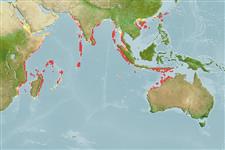Common names from other countries
Environment: milieu / climate zone / depth range / distribution range
Ecology
Marine; reef-associated; depth range 1 - 15 m (Ref. 9710). Tropical; 25°N - 27°S, 34°E - 141°E
Indian Ocean: East Africa south to 27°S and east to Indonesia.
Size / Weight / Age
Maturity: Lm ? range ? - ? cm
Max length : 20.0 cm TL male/unsexed; (Ref. 5372)
Found on the reef edge and upper slope. Usually in current-prone habitats; juveniles secretive in corals (Ref. 48636). Generally seen in pairs or in small aggregations (Ref. 4858). Feed mainly on invertebrates (Ref. 6113). Oviparous (Ref. 205). Form pairs during breeding (Ref. 205). Indian Ocean species counterpart of sibling Chaetodon ulietensis which is found in western and central Pacific (Ref. 90102).
Life cycle and mating behavior
Maturities | Reproduction | Spawnings | Egg(s) | Fecundities | Larvae
Distinct pairing (Ref. 205). Monogamous mating is observed as both obligate and social (Ref. 52884).
Heemstra, P.C., 1986. Chaetodontidae. p. 627-632. In M.M. Smith and P.C. Heemstra (eds.) Smiths' sea fishes. Springer-Verlag, Berlin. (Ref. 5372)
IUCN Red List Status (Ref. 130435)
CITES (Ref. 128078)
Not Evaluated
Threat to humans
Harmless
Human uses
Fisheries: commercial; aquarium: commercial
Tools
Special reports
Download XML
Internet sources
Estimates based on models
Preferred temperature (Ref.
115969): 26.2 - 29.3, mean 28.2 (based on 766 cells).
Phylogenetic diversity index (Ref.
82804): PD
50 = 0.5000 [Uniqueness, from 0.5 = low to 2.0 = high].
Bayesian length-weight: a=0.02291 (0.01133 - 0.04632), b=3.00 (2.83 - 3.17), in cm Total Length, based on LWR estimates for this Genus-body shape (Ref.
93245).
Trophic level (Ref.
69278): 3.5 ±0.37 se; based on food items.
Resilience (Ref.
120179): High, minimum population doubling time less than 15 months (Preliminary K or Fecundity.).
Fishing Vulnerability (Ref.
59153): Low vulnerability (10 of 100).
